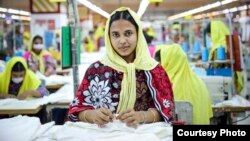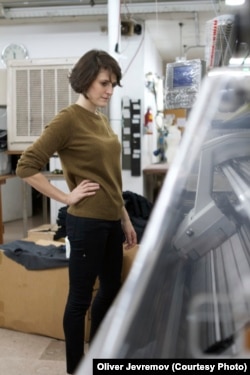A few years ago, Maxine Bédat — who is now in her early 30s — looked in her closet. It was full of clothes, but she had nothing to wear.
“And that was because it was a closet full of fast fashion that was falling part, that was based on hyper-trends from one season to the next.”
“Fast fashion” means clothes that are inexpensive but look like the latest designs from top fashion houses. Well-known fast fashion stores include H&M, Forever 21, Zara and Topshop.
One reason for the success of fast fashion is social media. A report by the investment research firm Bernstein found that Millennials — people born in the 1980s and ‘90s — want to wear a variety of clothes in the photos they post on Facebook, Instagram and Twitter. As a result, many businesses that offer trendy, low-cost clothes are growing.
Slow fashion
But some Millennials are not happy with the rise of fast fashion.
Maxine Bédat, the woman with the closet full of clothes but nothing to wear, calls fast fashion “exhausting.” She says she was tired of always shopping for what was in style. Instead, she says, she wanted to buy fewer clothes that she could wear over and over. Other people wanted the same thing, she says.
“I just saw a post today from one of the biggest bloggers, and it’s ‘what is her favorite white t-shirt?’ And I think that’s really, you know, telling about where we are today. It’s not just about having something new every single day, but what is something that’s beautiful, and what is something that’s quality, and what brands do we want to be wearing that reflect the values that we hold?”
So Ms. Bédat and a business partner, Soraya Darabi, started a “slow fashion” clothing company called Zady.
“Slow fashion” means clothes that last a long time. They are often classic colors and shapes, and are made from natural materials that are biodegradable over time.
The terms “fast fashion” and “slow fashion” are related to “fast food” and “slow food”: fast food is still popular in the U.S., but many restaurants increasingly offer higher-quality, more expensive and relaxed meals.
Like slow food, slow fashion also aims to use sources that are good for the environment and workers. Maxine Bédat says people in her generation want to know where their clothes come from and who is making them. Their interest comes in part after a clothing factory collapsed in Bangladesh in 2013. Over 1,000 people who were making cheap clothes in poor conditions died.
To answer Millennials’ demand for information about the products they buy, Ms. Bédat’s company, Zady, includes details about the history of the brands. It also describes the process by which the clothes are made. Ms. Bédat says Zady aims to tell shoppers where their clothes come from, where they go, and how they impact the world.
Another approach: recycling clothes
The international business H&M is answering Millennials’ demands for stylish but sustainable fashion in another way. It has created a recycling program for clothes. The program invites people to bring clothes they no longer want to H&M stores. Shoppers who donate old clothes can receive a discount on new things they buy.
H&M does several things with shoppers’ old clothes. They sell some clothes again. They turn some clothes into other useful items, such as cleaning cloths. And they reduce the rest to fibers that can be re-used as building materials, for instance.
An H&M spokesperson wrote in an email to VOA that the program aims to help the environment. “We have a clear vision to avoid and minimize waste that goes into landfills,” the spokesperson wrote.
H&M reported that in 2014 it collected over 7,600 tons of unwanted clothing. That is about 38 million t-shirts.
I’m Kelly Jean Kelly.
Kelly Jean reported this story from Washington, DC. Kathleen Struck was the editor.
_______________________________________________________________
Words in This Story
hyper – prefix excessive or extreme
trendy – adj. currently popular or fashionable
biodegradable – adj. capable of being slowly destroyed and broken down into very small parts by natural processes
sustainable – adj. involving methods that do not completely use up or destroy natural resources







